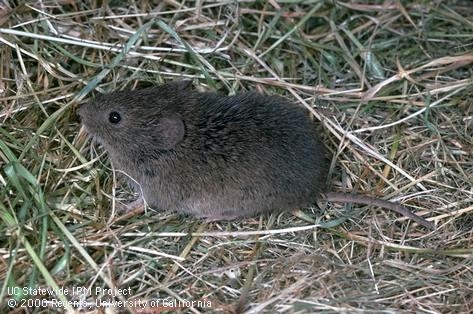Help for the Home Gardener from the Help Desk of the
UC Master Gardener Program of Contra Costa County

Help Desk Response: Thank you for contacting the UC Master Gardener Program Help Desk with your request for advice and tips on eliminating voles in your garden landscape.
Voles, also known as meadow mice, can be quite prevalent in home gardens. They have above-ground tunnels or pathways through vegetation, as well as underground tunnels. Entrances to their tunnels are small (1 1/2 to 2 inches) and are left open, not plugged. There may be many open tunnels within a small area. Voles are active both day and night, and emerge from their holes to forage for food.
Voles can cause damage to plants in your yard, as you've already experienced. They eat grasses and many landscape and vegetable plants, and can also damage trees by eating the bark. If trees lose their bark all the way around the trunk, it can kill the trees. So it is worthwhile to begin eliminating the voles now, before they do too much damage.
It is important to modify the habitat in your yard so that the voles do not have places to hide from predators. Keep your lawn mowed short to prevent them from forming above ground tunnels in the grass. If possible, mow or remove other nearby ground covers such as ivy. Voles don't like to be exposed on open ground where predators can attack them.
When the vole population is concentrated in a small area, trapping can be effective. For a small garden, consider using using at least 12 traps. You can use a simple, wooden mouse trap baited with a peanut butter-oatmeal mixture or apple slices. Place the traps near the tunnel entrances with the trigger end and bait near the opening. Check the traps daily and keep setting new traps until you no longer find them triggered. Use gloves when removing the voles from the traps, and either bury them or bag them and discard in the trash.
Once the voles are gone, destroy their tunnels by digging. This will discourage others from repopulating the tunnels from outside your yard. Additional specific information about managing voles can be found at this University of California website:
http://ipm.ucanr.edu/PMG/PESTNOTES/pn7439.html
If you have fruit trees or other prized trees, you can protect their trunks with plastic cylinder barriers as shown and described in the link above, or with metal roof flashing. Voles are not skilled at climbing, so the barrier does not need to be higher than 12 inches.
We hope that this information will help you to control your vole population. Please let us know if you need additional information.
Help Desk of the UC Master Gardener Program of Contra Costa County (SLH)
Note: The UC Master Gardeners Program of Contra Costa's Help Desk is available year-round to answer your gardening questions. Except for a few holidays, we're open every week, Monday through Thursday for walk-ins from 9:00 am to Noon at 75 Santa Barbara Road, 2d Floor, Pleasant Hill, CA 94523. We can also be reached via telephone: (925)646-6586, email: ccmg@ucanr.edu, or on the web at http://ccmg.ucanr.edu/Ask_Us/ MGCC Blogs can be found at http://ccmg.ucanr.edu/HortCoCo/ You can also subscribe to the Blog (http://ucanr.edu/blogs/CCMGBlog/).

